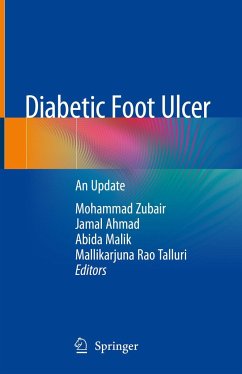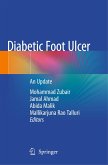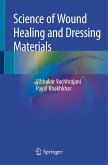Diabetic Foot Ulcer
An Update
Herausgegeben:Zubair, Mohammad; Ahmad, Jamal; Malik, Abida; Talluri, Mallikarjuna Rao
Diabetic Foot Ulcer
An Update
Herausgegeben:Zubair, Mohammad; Ahmad, Jamal; Malik, Abida; Talluri, Mallikarjuna Rao
- Gebundenes Buch
- Merkliste
- Auf die Merkliste
- Bewerten Bewerten
- Teilen
- Produkt teilen
- Produkterinnerung
- Produkterinnerung
This book discusses essential aspects of diabetic foot ulcers, including evidence-based information on its pathogenesis and pathophysiology, as well as the molecular mechanisms and biomechanics of the diabetic foot. It also highlights the need for a multidisciplinary team to be involved in the management of diabetic patients with foot ulcers, and describes available and future tools for evaluating patients who are at risk. Exploring the main current therapies as well as the latest developments, future directions and potential new treatments, such as growth factors, stem cell therapy,…mehr
Andere Kunden interessierten sich auch für
![Diabetic Foot Ulcer Diabetic Foot Ulcer]() Diabetic Foot Ulcer82,99 €
Diabetic Foot Ulcer82,99 €![Home Long-Term Oxygen Treatment in Italy Home Long-Term Oxygen Treatment in Italy]() R.W. Dal Negro / A.I. Goldberg (eds.)Home Long-Term Oxygen Treatment in Italy53,99 €
R.W. Dal Negro / A.I. Goldberg (eds.)Home Long-Term Oxygen Treatment in Italy53,99 €![Influenza Influenza]() Influenza153,99 €
Influenza153,99 €![Influenza Influenza]() Influenza105,99 €
Influenza105,99 €![Diabetic Retinopathy Diabetic Retinopathy]() David J. Browning (Hrsg.)Diabetic Retinopathy164,99 €
David J. Browning (Hrsg.)Diabetic Retinopathy164,99 €![When Puberty Is Precocious When Puberty Is Precocious]() When Puberty Is Precocious163,99 €
When Puberty Is Precocious163,99 €![Science of Wound Healing and Dressing Materials Science of Wound Healing and Dressing Materials]() Vibhakar VachhrajaniScience of Wound Healing and Dressing Materials64,99 €
Vibhakar VachhrajaniScience of Wound Healing and Dressing Materials64,99 €-
-
-
This book discusses essential aspects of diabetic foot ulcers, including evidence-based information on its pathogenesis and pathophysiology, as well as the molecular mechanisms and biomechanics of the diabetic foot. It also highlights the need for a multidisciplinary team to be involved in the management of diabetic patients with foot ulcers, and describes available and future tools for evaluating patients who are at risk. Exploring the main current therapies as well as the latest developments, future directions and potential new treatments, such as growth factors, stem cell therapy, alternative medicine and nanotechnology, the book is a valuable resource for clinicians and medical graduates but will also appeal to researchers working in the field.
Produktdetails
- Produktdetails
- Verlag: Springer / Springer Nature Singapore / Springer, Berlin
- Artikelnr. des Verlages: 978-981-15-7638-6
- 1st ed. 2021
- Seitenzahl: 357
- Erscheinungstermin: 6. Oktober 2020
- Englisch
- Abmessung: 23mm x 162mm x 237mm
- Gewicht: 820g
- ISBN-13: 9789811576386
- ISBN-10: 9811576386
- Artikelnr.: 59955623
- Herstellerkennzeichnung
- Libri GmbH
- Europaallee 1
- 36244 Bad Hersfeld
- gpsr@libri.de
- Verlag: Springer / Springer Nature Singapore / Springer, Berlin
- Artikelnr. des Verlages: 978-981-15-7638-6
- 1st ed. 2021
- Seitenzahl: 357
- Erscheinungstermin: 6. Oktober 2020
- Englisch
- Abmessung: 23mm x 162mm x 237mm
- Gewicht: 820g
- ISBN-13: 9789811576386
- ISBN-10: 9811576386
- Artikelnr.: 59955623
- Herstellerkennzeichnung
- Libri GmbH
- Europaallee 1
- 36244 Bad Hersfeld
- gpsr@libri.de
Dr Mohammad Zubair is an Assistant Professor at the Department of Medical Microbiology, Faculty of Medicine, University of Tabuk, Kingdom of Saudi Arabia. He completed his PhD and post-doctorate research on diabetic foot infections and has extensive teaching and research experience in the field of medical science. His research focuses on the extended spectrum beta-lactamase gene (CTX, TEM & SHV), pro and anti-inflammatory cytokines and healing proteins and their clinical correlations. He has published more than 35 papers in international, peer-reviewed journals, and has presented his work at various international conferences. He is also the recipient of one of the prestigious "Marvil Levin" research awards presented by the American Diabetes Association (ADA) at the 72nd Scientific Session held at Philadelphia, USA. Dr Jamal Ahmad is a former Professor of Endocrinology; ex Dean of the Faculty of Medicine, J.N. Medical College; and ex Director of the Rajiv Gandhi Centre for Diabetes & Endocrinology, Faculty of Medicine, Aligarh Muslim University, India. He has made a significant contribution toward determining the role of protein glycation in diabetes and its associated complications. He has published more than 240 research articles in various international and national journals, was Principal Investigator or Co-Investigator in a number of research projects, and has completed 9 phase III international, multi-centre, multicounty new drug trials in diabetes mellitus. He is a former President of the Endocrine Society of India, and the recipient of the prestigious RSSDI fellowship-2015 and a Lifetime Achievement Award by Diabetes India 2019. Dr Abida Malik is a former Professor and Chairperson of the Department of Microbiology, and the former Dean of the Faculty of Medicine, Jawaharlal Nehru Medical College, Aligarh Muslim University. A leading Indian microbiologist, she has over 41 years of teaching and research experience and authored more that 185 publications. She established the Virology Lab in 1976, Mycology lab in 1980 and was founded and was responsible for the AIDS Surveillance Centre for 20 years. She is the former president of the Indian Association of Microbiologists, and received the Dr UC Chaturvedi Life Time achievement Award for her services to microbiology in 2011. Dr. Mallikrjuna Rao. Talluri is currently a Research Associate at AXIS Clinicals Limited, Hyderabad, India, where his work focuses on development methods and the quantification of new drugs and their bioavailability and bioequivalence. He is an expert on the evaluation of the biological activities of natural products (bio-guided extraction), and scientific writing, and has experience in instrumental handling, such as LC-MS/MS, HPLC, column chromatography, and TLC. He has worked extensively in the field of phytopharmacology, and has published more than 50 papers in peer-reviewed, international and national journals.
Part I Diabetic Foot Complications: World Preview1Diabetic-Foot Complications in Asian & European continents
2Diabetic-Foot Complications in African and Antarctica continents
3Diabetic-Foot Complications in American and Australian continentsPart II Diabetic Foot: Complications & Treatments Updates4Pathogenesis, pathophysiology, polyneuropathy and micro/macro vascular changes in Diabetic foot
5Screening of foot inflammation in diabetic patients by Non-invasive imaging modalities
6Molecular mechanism & Biomechanics of the Diabetic Foot: The Road to Foot Ulceration and healing
7Foot Pressure Abnormalities, Radiographic and Charcot Changes in the Diabetic Foot 8The Temporary Orthesio-therapy for Diabetic foot
9Genetics of Fractured and non-fractured wound healing in DFU
10Acute and chronic wound healing physiology11Aerobic and Anaerobic bacterial infections and Treatment strategies
12MRSA, EBSL, MDRO and Biofilm formation in Diabetic Foot Ulcer infections and its treatment modifications13Fungal infection: the hidden enemy?
14Heat Shock Protein and Diabetic footPart III Diabetic Foot: Developments, Future prospective, New possible treatments16Advances in Prevention and empirical treatment of Diabetic foot infection17Low Cost management in Diabetic Foot
18Role of Growth Factors in the Treatment of Diabetic Foot Ulceration
19Stem cells in the treatment of diabetic foot ulcers
20Alternative medicine in the Management of Diabetic Foot Ulcers/infections
21Nanotechnology and DFU: Future prospects22Modern phytomedicine in treating diabetic: progress and opportunities23Role of Paramedics in diabetic foot management
2Diabetic-Foot Complications in African and Antarctica continents
3Diabetic-Foot Complications in American and Australian continentsPart II Diabetic Foot: Complications & Treatments Updates4Pathogenesis, pathophysiology, polyneuropathy and micro/macro vascular changes in Diabetic foot
5Screening of foot inflammation in diabetic patients by Non-invasive imaging modalities
6Molecular mechanism & Biomechanics of the Diabetic Foot: The Road to Foot Ulceration and healing
7Foot Pressure Abnormalities, Radiographic and Charcot Changes in the Diabetic Foot 8The Temporary Orthesio-therapy for Diabetic foot
9Genetics of Fractured and non-fractured wound healing in DFU
10Acute and chronic wound healing physiology11Aerobic and Anaerobic bacterial infections and Treatment strategies
12MRSA, EBSL, MDRO and Biofilm formation in Diabetic Foot Ulcer infections and its treatment modifications13Fungal infection: the hidden enemy?
14Heat Shock Protein and Diabetic footPart III Diabetic Foot: Developments, Future prospective, New possible treatments16Advances in Prevention and empirical treatment of Diabetic foot infection17Low Cost management in Diabetic Foot
18Role of Growth Factors in the Treatment of Diabetic Foot Ulceration
19Stem cells in the treatment of diabetic foot ulcers
20Alternative medicine in the Management of Diabetic Foot Ulcers/infections
21Nanotechnology and DFU: Future prospects22Modern phytomedicine in treating diabetic: progress and opportunities23Role of Paramedics in diabetic foot management
Part I Diabetic Foot Complications: World Preview1Diabetic-Foot Complications in Asian & European continents
2Diabetic-Foot Complications in African and Antarctica continents
3Diabetic-Foot Complications in American and Australian continentsPart II Diabetic Foot: Complications & Treatments Updates4Pathogenesis, pathophysiology, polyneuropathy and micro/macro vascular changes in Diabetic foot
5Screening of foot inflammation in diabetic patients by Non-invasive imaging modalities
6Molecular mechanism & Biomechanics of the Diabetic Foot: The Road to Foot Ulceration and healing
7Foot Pressure Abnormalities, Radiographic and Charcot Changes in the Diabetic Foot 8The Temporary Orthesio-therapy for Diabetic foot
9Genetics of Fractured and non-fractured wound healing in DFU
10Acute and chronic wound healing physiology11Aerobic and Anaerobic bacterial infections and Treatment strategies
12MRSA, EBSL, MDRO and Biofilm formation in Diabetic Foot Ulcer infections and its treatment modifications13Fungal infection: the hidden enemy?
14Heat Shock Protein and Diabetic footPart III Diabetic Foot: Developments, Future prospective, New possible treatments16Advances in Prevention and empirical treatment of Diabetic foot infection17Low Cost management in Diabetic Foot
18Role of Growth Factors in the Treatment of Diabetic Foot Ulceration
19Stem cells in the treatment of diabetic foot ulcers
20Alternative medicine in the Management of Diabetic Foot Ulcers/infections
21Nanotechnology and DFU: Future prospects22Modern phytomedicine in treating diabetic: progress and opportunities23Role of Paramedics in diabetic foot management
2Diabetic-Foot Complications in African and Antarctica continents
3Diabetic-Foot Complications in American and Australian continentsPart II Diabetic Foot: Complications & Treatments Updates4Pathogenesis, pathophysiology, polyneuropathy and micro/macro vascular changes in Diabetic foot
5Screening of foot inflammation in diabetic patients by Non-invasive imaging modalities
6Molecular mechanism & Biomechanics of the Diabetic Foot: The Road to Foot Ulceration and healing
7Foot Pressure Abnormalities, Radiographic and Charcot Changes in the Diabetic Foot 8The Temporary Orthesio-therapy for Diabetic foot
9Genetics of Fractured and non-fractured wound healing in DFU
10Acute and chronic wound healing physiology11Aerobic and Anaerobic bacterial infections and Treatment strategies
12MRSA, EBSL, MDRO and Biofilm formation in Diabetic Foot Ulcer infections and its treatment modifications13Fungal infection: the hidden enemy?
14Heat Shock Protein and Diabetic footPart III Diabetic Foot: Developments, Future prospective, New possible treatments16Advances in Prevention and empirical treatment of Diabetic foot infection17Low Cost management in Diabetic Foot
18Role of Growth Factors in the Treatment of Diabetic Foot Ulceration
19Stem cells in the treatment of diabetic foot ulcers
20Alternative medicine in the Management of Diabetic Foot Ulcers/infections
21Nanotechnology and DFU: Future prospects22Modern phytomedicine in treating diabetic: progress and opportunities23Role of Paramedics in diabetic foot management








